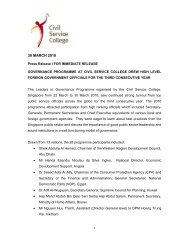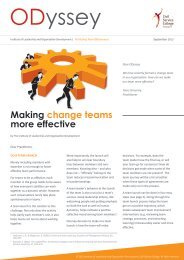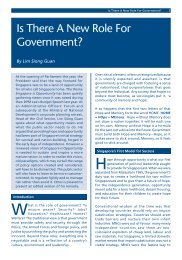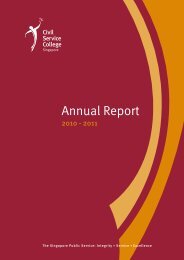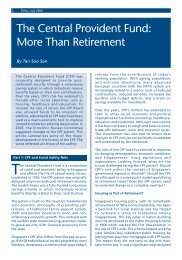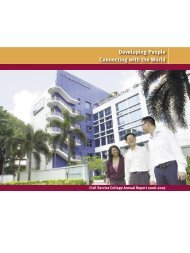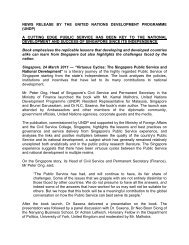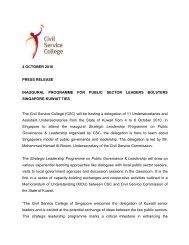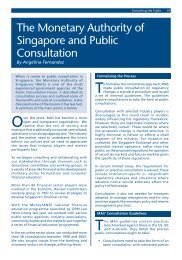Public Consultation Toolkit - Civil Service College
Public Consultation Toolkit - Civil Service College
Public Consultation Toolkit - Civil Service College
Create successful ePaper yourself
Turn your PDF publications into a flip-book with our unique Google optimized e-Paper software.
<strong>Public</strong> <strong>Consultation</strong> <strong>Toolkit</strong> 13 14 <strong>Public</strong> <strong>Consultation</strong> <strong>Toolkit</strong><br />
Considerations for facilitating effective partnerships<br />
Agencies can do the following to facilitate effective partnerships:<br />
1. Lead time. When tapping on partners, it is important to provide them with sufficient lead<br />
time to allow the partner agencies to mobilise the necessary resources. Agencies should<br />
provide a minimum of one month’s notice to the partners, and a period of at least three<br />
months for the partners to gather feedback on agencies’ behalf.<br />
2. Information. Agencies should provide partners with comprehensive information so that<br />
they have a good understanding of the policy and its considerations before the consultation<br />
process. This allows the partners to be more effective in addressing the questions raised by<br />
their constituents/members during the actual consultation exercise.<br />
3. Materials. Agencies should generally equip partners with communication materials for the<br />
consultation exercise. This may include briefing slides (with speakers’ notes), pamphlets and<br />
FAQs.<br />
4. Funding and technical support. Agencies can also provide technical assistance (e.g., design<br />
of survey questions) and funding support (e.g., for organising dialogue sessions).<br />
Note: The above are some suggestions but are not exhaustive.<br />
Case 3:<br />
The Living Murray River Restoration<br />
Agency/country:<br />
• Murray-Darling Basin Commission, Australia<br />
Background:<br />
• The Murray-Darling Basin (MDB) comprises a large geographical area that spreads across five<br />
states and territories: Queensland, the Australian Capital Territory, New South Wales, Victoria<br />
and South Australia.<br />
• The landscape of the MDB was under severe ecological stress, with issues such as salinity,<br />
poor water quality, stressed forests, dried wetlands, threatened native species, feral animals<br />
and noxious weeds.<br />
• The Australian government engaged different stakeholders in the restoration of the<br />
cleanliness and health of the MDB.<br />
<strong>Consultation</strong> Process:<br />
Stakeholders engaged during the consultation exercise included:<br />
• Individuals/organisations who could benefit from the restoration<br />
- Local communities (e.g., landholders, land managers)<br />
- Rural communities (e.g., indigenous people)<br />
• Individuals/organisations who could be adversely affected<br />
- Industry stakeholders, including businesses that depended on the river’s resources as a<br />
form of income (e.g., agricultural farmers)<br />
• Individuals/organisations who had the skills and resources to contribute to river restoration<br />
- Ecological and environmental experts<br />
• Individuals/organisations who were interested in the restoration<br />
- Activists (e.g., land care groups)<br />
- Interest groups and individuals who had an interest in the river’s health



